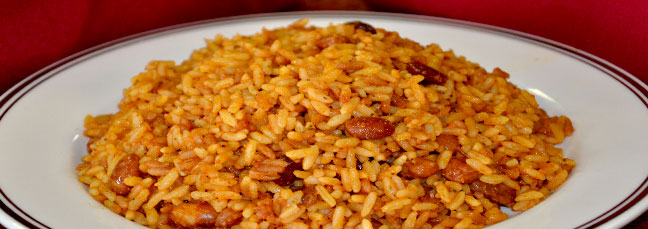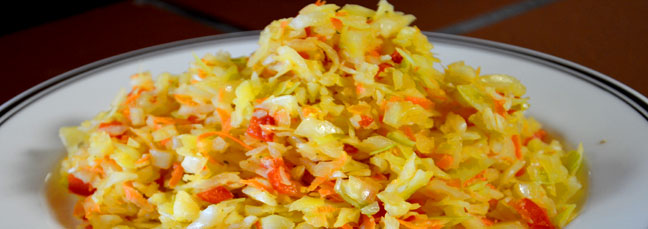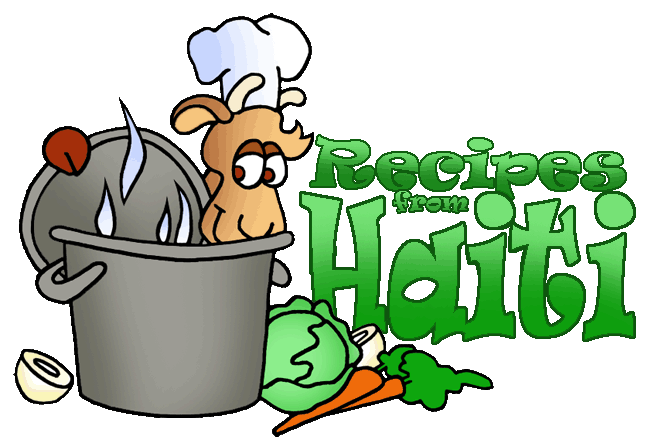Recipes from
Haiti
Whenever
I think of eating in Haiti, the first food that pops into my mind is
goat. I think it's the only place in all of my travels where I
ever ate goat. But, I'm not providing a recipe for goat.
Seriously, where would you ever find goat meat?
On my original trip around the island, I traveled with Haitians and ate Haitian food. The menu always included rice and beans. Every day! Fortunately for me, if somebody else prepares the food, I enjoy it. So, I merrily ate rice and beans ever day. One of my friends I met on this trip, Joyce, gave me her recipe for the dish. I have had the recipe for decades and never once made rice and beans. I guess I had enough of them that summer.

Cook the beans about one hour or until they break, remove the water, but save it. Fry up the bacon, toss in salt, pepper, and garlic to taste and the throw in the beans. Cook it all together about five minutes, and then add the bean water.
After it boils, add the rice and green dill pepper. I personally have no idea what green dill pepper is. I don't think that had any influence in my not making this dish over the years.
Remove the pepper after 4 or 5 minutes and toss in the cloves. Cook the water away, lower the heat, and cover the rice and beans. Continue to cook slowly for fifteen minutes more.
Now, Joyce never once mentioned anything about peppers. However, in my experience with Haitian cooking, it usually comes a little on the hot and spicy side of life. So, if you feel inclined to dice up a jalapeño or scotch bonnet pepper (or more if you like some fire in your mouth) do as the Haitians do. I am certain it would please your Haitian guests and me. No, Joyce didn't do this, but I liked her attitude. She claimed, "Cooking comes from the heart as well as the hearth!"
Seeing is not always believing when it comes to Haitian food. In preparation for this most recent trip to Haiti, my group met at a Haitian restaurant not far from where I live. One of the dishes served was pikliz. It looks like good old American Coleslaw. Exactly like it! So, if you scooped a pile of it on your plate and then took a huge refreshing mouthful, you might just catch your mouth on fire (or spit it out like one teenage girl with the group). Yep, it isn't what it appears to be. If you like spicy hot, like I do, you will love it on every occasion possible. And, I enjoyed it several times while in Haiti. But, if you don't like spicy, well . . . be warned that it isn't what it appears to be and you might just want to skip the fire.
Of course, I had to get the recipe. And, the best source for me were the cooks at the Haitian restaurant who also spoke perfect English. I went back for a cooking lesson.

On my original trip around the island, I traveled with Haitians and ate Haitian food. The menu always included rice and beans. Every day! Fortunately for me, if somebody else prepares the food, I enjoy it. So, I merrily ate rice and beans ever day. One of my friends I met on this trip, Joyce, gave me her recipe for the dish. I have had the recipe for decades and never once made rice and beans. I guess I had enough of them that summer.
Joyce's
Rice and Beans
Port-au-Prince, Haiti
Port-au-Prince, Haiti

|
1 cup red beans
2
or 3 pieces of bacon
salt
and pepper to taste
garlic
to taste
|
1
cup rice 1 green dill pepper 5 or 6 cloves 1 hot pepper, diced |
Cook the beans about one hour or until they break, remove the water, but save it. Fry up the bacon, toss in salt, pepper, and garlic to taste and the throw in the beans. Cook it all together about five minutes, and then add the bean water.
After it boils, add the rice and green dill pepper. I personally have no idea what green dill pepper is. I don't think that had any influence in my not making this dish over the years.
Remove the pepper after 4 or 5 minutes and toss in the cloves. Cook the water away, lower the heat, and cover the rice and beans. Continue to cook slowly for fifteen minutes more.
Now, Joyce never once mentioned anything about peppers. However, in my experience with Haitian cooking, it usually comes a little on the hot and spicy side of life. So, if you feel inclined to dice up a jalapeño or scotch bonnet pepper (or more if you like some fire in your mouth) do as the Haitians do. I am certain it would please your Haitian guests and me. No, Joyce didn't do this, but I liked her attitude. She claimed, "Cooking comes from the heart as well as the hearth!"
Seeing is not always believing when it comes to Haitian food. In preparation for this most recent trip to Haiti, my group met at a Haitian restaurant not far from where I live. One of the dishes served was pikliz. It looks like good old American Coleslaw. Exactly like it! So, if you scooped a pile of it on your plate and then took a huge refreshing mouthful, you might just catch your mouth on fire (or spit it out like one teenage girl with the group). Yep, it isn't what it appears to be. If you like spicy hot, like I do, you will love it on every occasion possible. And, I enjoyed it several times while in Haiti. But, if you don't like spicy, well . . . be warned that it isn't what it appears to be and you might just want to skip the fire.
Of course, I had to get the recipe. And, the best source for me were the cooks at the Haitian restaurant who also spoke perfect English. I went back for a cooking lesson.
Adeline
and Jean's Pikliz
Columbus, Ohio by way of Haiti
Columbus, Ohio by way of Haiti

|
½
head shredded cabbage
2
carrots, pealed, chapped
1
onion, thinly sliced
6
scotch bonnet peppers |
4
to 6 garlic cloves 1 tsp salt 8 to 10 peppercorns 3 cups white vinegar |
This
recipe calls for 6 hot peppers. That will, of course, put your
mouth on fire. So, if you are afraid of that, cut back on the
peppers. However many peppers you use, cut off the ends and then
cut the peppers in thin slices.
Put all of the ingredients into a large container that can be sealed tightly. Mix everything up well and top all of the ingredients with the vinegar. If you are inspired to dance around the kitchen after sealing the container, be sure it is to a Caribbean beat. Hide your sealed container in the back of the refrigerator from 24 to 48 hours.
If you happen to live in a house that has leftovers, this is the dish for you. Pikliz can last up to two months in the fridge. I don't usually tamper with success, but if you want variety in your pikliz, there are several vegetables that you could add to your slaw including bell peppers, jalapeño peppers, chopped green tomatoes (never, and I can say never here with certainty), cauliflower, and/or peas.
Put all of the ingredients into a large container that can be sealed tightly. Mix everything up well and top all of the ingredients with the vinegar. If you are inspired to dance around the kitchen after sealing the container, be sure it is to a Caribbean beat. Hide your sealed container in the back of the refrigerator from 24 to 48 hours.
If you happen to live in a house that has leftovers, this is the dish for you. Pikliz can last up to two months in the fridge. I don't usually tamper with success, but if you want variety in your pikliz, there are several vegetables that you could add to your slaw including bell peppers, jalapeño peppers, chopped green tomatoes (never, and I can say never here with certainty), cauliflower, and/or peas.
